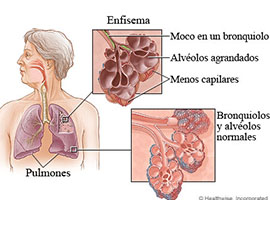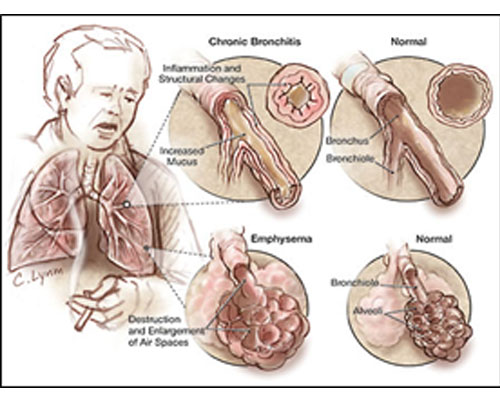 Is a long-term, progressive disease of the lungs, that primarily causes shortness of breath due to over-inflation of the alveoli (air sacs in the lung).
Is a long-term, progressive disease of the lungs, that primarily causes shortness of breath due to over-inflation of the alveoli (air sacs in the lung).
In people with emphysema, the lung tissue involved in exchange of gases (oxygen and carbon dioxide) is impaired or destroyed.
Emphysema is included in a group of diseases called: chronic obstructive pulmonary disease or COPD (pulmonary refers to the lungs).
Emphysema
is called an obstructive lung disease because airflow on exhalation is slowed or stopped because over-inflated alveoli do not exchange gases when a person breaths due to little or no movement of gases out of the alveoli.
Emphysema changes the anatomy of the lung in several important ways. This is due to in part to the destruction of lung tissue around smaller airways.
This tissue normally holds these small airways, called bronchioles, open, allowing air to leave the lungs on exhalation. When this tissue is damaged, these airways collapse, making it difficult for the lungs to empty and the air (gases) becomes trapped in the alveoli.
Emphysema Causes:
•Cigarette smoking is by far the most dangerous behavior that causes people to develop emphysema, and it is also the most preventable cause.
Cigarette smoke directly affects the cells in the airway responsible for clearing mucus and other secretions. Occasional smoking temporarily disrupts the sweeping action of tiny hairs called cilia that line the airways.
Continued smoking leads to longer dysfunction of the cilia. Long-term exposure to cigarette smoke causes the cilia to disappear from the cells lining the air passages.
Without the constant sweeping motion of the cilia, mucous secretions cannot be cleared from the lower respiratory tract. Furthermore, smoke causes mucous secretion to be increased at the same time that the ability to clear the secretions is decreased. The resulting mucous buildup can provide bacteria and other organisms with a rich source of food and lead to infection.
•Deficiency of an enzyme called alpha-1-antitrypsin,
•air pollution,
•airway reactivity,
•heredity,
•male sex,
•age.
SYMPTOM
•The most common symptom is: shortness of breath.
•Cough,
•Tolerance for exercise decreases over time..
SIGNS
•One of the hallmark signs of emphysema is "pursed-lipbreathing." The person with emphysema struggles to exhale completely, in an attempt to empty trapped air. They purse their lips, leaving only a small opening. Then, when they exhale, the lips block the flow of air, increasing pressure in the collapsed airways, and opening them, allowing the trapped air to empty.
•People with emphysema may develop a "barrel chest," where the distance from the chest to the back, which is normally less than the distance side to side, becomes more pronounced. This is a direct result of air becoming trapped behind obstructed airways.
In treatment of pulmonary diseases, autologous stem cells are stimulated to increase in numbers by natural growth factors.
Once the desired volume of stem cells are available, they are extracted from the patient’s own blood, adipose tissue or bone marrow.
The stem cells are then washed, isolated and returned to the patient intravenously or through the use of a nebulizer.
Once the cells are returned to the patient, they will begin to regenerate new lung tissue. Since stem cells can continually replicate, the lungs will progressively grow stronger, and patients will be able to breathe easier.


Av. Masferrer South. Urb. Maquilishuat No. 1006. San Salvador, El Salvador. CA.
(503) 2268-5999 Fax. 2268-5910
www.stemcell-elsalvador.com - info@stemcell-elsalvador.com